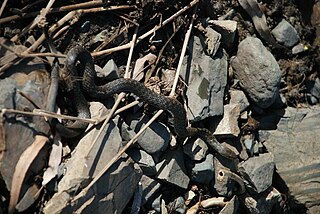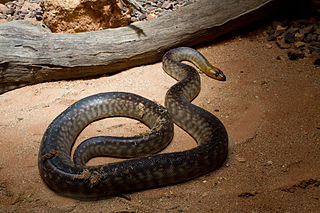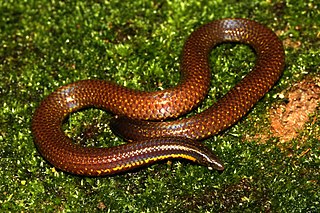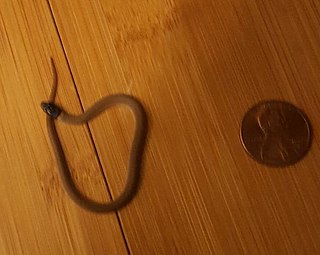The Key tegu is a species of lizard in the family Gymnophthalmidae. The species is endemic to Ecuador.

The tiger snake is a large and highly venomous snake of southern Australia, including its coastal islands and Tasmania. These snakes are often observed and locally well known by their banding, black and yellow like a tiger, although the species can be highly variable in coloration and patterning. All populations are classified within the genus Notechis (Elapidae). Their diverse characteristics have been classified either as distinct species or by subspecies and regional variation.

The common keelback, also known as Mair's keelback, is a species of nonvenomous snake in the family Colubridae. The species is endemic to Australasia.

The woma python, also known commonly as Ramsay's python, the sand python, and simply the woma, is a species of snake in the family Pythonidae, endemic to Australia. Once common throughout Western Australia, it has become critically endangered in some regions.
Tropidolaemus huttoni is a little-known species of pit viper, a venomous snake in the subfamily Crotalinae of the family Viperidae. The species is endemic to the southern Western Ghats of India. There are no subspecies that are currently recognized. Little is known about this species, as this species is known only from two young individuals, based on which it was first described in 1949. Despite long-term and targeted herpetological surveys in the particular hill range (Meghamalai), it has never been re-sighted there or elsewhere since then.
The purple-red earth snake is a species of nonvenomous shield tail snake, endemic to southern India. No subspecies are currently recognized.
Uropeltis broughami, commonly known as Brougham's earth snake or the Sirumalai shieldtail, is a species of snake in the family Uropeltidae. The species is endemic to the Western Ghats in southern India.

Uropeltis ellioti, commonly known as Elliot's earth snake and Elliot's shieldtail, is a species of snake in the family Uropeltidae. The species is endemic to India.

Uropeltis phipsonii, commonly known as Phipson's earth snake and Phipson's shieldtail, is a species of snake in the family Uropeltidae. The species is endemic to India.

Tantilla hobartsmithi, commonly known as the southwestern blackhead snake, is a species of small colubrid snake native to the southwestern United States and northern Mexico.
Garthius chaseni, commonly known as Chasen's mountain pit viper, Chasen's tree viper, and the Kinabalu brown pit viper, is a species of venomous pitviper in the family Viperidae. The species is endemic to the island of Borneo in Malaysia. No subspecies are currently recognized. It is monotypic in the genus Garthius.
The spotted mulga snake, also known commonly as Butler's black snake and Butler's snake, is a species of venomous snake in the family Elapidae. The species is endemic to Western Australia. It is a member of the genus Pseudechis, dangerously venomous snakes that can intimidate an opponent by raising the head and presenting a hood. This cobra-like threat display is supported by the ability to produce a very large amount of venom.

Hydrophis peronii, commonly known as the horned sea snake, Peron's sea snake, and the spiny-headed seasnake, is a species of venomous snake in the subfamily Hydrophiinae of the family Elapidae. The species is endemic to the western tropical Pacific Ocean. It is the only sea snake with spines on the head. It is sometimes placed in its own genus Acalyptophis.
Rhinophis blythii, or Blyth's earth snake, is a species of snake in the family Uropeltidae. The species is endemic to the rain forests and grasslands of Sri Lanka.

Tropidophis feicki, also known commonly as the broad-banded dwarf boa, the broad-banded trope, and Feick's dwarf boa, is a species of non-venomous snake in the family Tropidophiidae. The species is endemic to Cuba.
Parapistocalamus is a genus of venomous snake in the family Elapidae.

Toxicodryas pulverulenta, commonly known as Fischer's cat snake, Fischer's tree snake, and the powdered tree snake, is a species of rear-fanged venomous snake in the family Colubridae. The species is native to Sub-Saharan Africa.
Emmochliophis is a genus of snakes in the family Colubridae. The genus is endemic to Ecuador.
Geophis championi, the Panamenian earth snake, is a species of snake in the family Colubridae. The species is endemic to Panama.
Erythrolamprus guentheri, also known commonly as Günther's false coral snake, is a species of snake in the subfamily Dipsadinae of the family Colubridae. The species is native to Ecuador and Peru.









